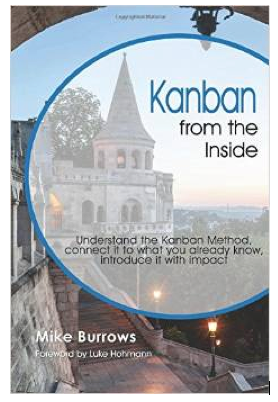HiveMind and Agile Expert Mike Burrows recently released a new book; Kanban from the Inside – An in-depth look at how managers of organisations can shift towards a culture of business agility and optimum quality whilst at the same time creating seamless flow.
Mike is the UK Director of David J Anderson & Associates, which is important to note as David Anderson is often credited with the formulation of the present day Kanban technique, as it’s applied to knowledge work and IT.
InfoQ spoke to Mike about the release of his new book, which he summarises by saying: “understand the Kanban Method, connect it with familiar models such as Lean, Agile, and Theory of Constraints, and learn how to implement it step-by-step in your organization. Learn practical techniques to apply the Kanban Method, always considering the context of your situation and the people involved.”
You can view a sample of Kanban From The Inside here.
Below is an excerpt of the interview:
 InfoQ: The first part of the book covers the Kanban values. What makes these values important?
InfoQ: The first part of the book covers the Kanban values. What makes these values important?
Mike: Far from being fluffy, fragile, or merely the tool of corporate spin doctors, values turn out to be surprisingly robust and practical. Whether we are aware of them or not, they help to explain what we actually do now, not just what we aspire to. At the same time, they describe the benefits we expect from doing things the way we do them.
In nine values—transparency, balance, collaboration, customer focus, flow,leadership, understanding, agreement, and respect—I can describe not only how the stated principles and practices of the Kanban Method work, but also the thinking behind features found in more mature implementations. This makes them a useful shorthand. When teams prioritize values (through the Kanban Values Exercise or Kanban Knowsy, perhaps), they are prioritizing changes in practice, presumably because they are eager to receive the corresponding benefits. And when these priorities have strong echoes elsewhere—for example in Agile with collaboration, in Lean with flow, or in Systems Thinking with understanding—you know that you will not be short of outside inspiration from which to draw.
Conversely (and this is advice that applies not just to Kanban), if a value seems incompatible somehow with the prevailing culture, you can expect a harder time when trying to implement its corresponding practices….
InfoQ: Balancing the interests of the stakeholders often isn’t easy. How can kanban help to do this?
Mike: At its most straightforward, I have more than once found it necessary as a manager to make sure that the allocation of effort across our various customer groups is seen to be equitable. In my experience, doing this transparently and proactively helps to level the load across the course of the year. Once trust is earned, customers may become more willing to make sacrifice their selfish, short term interest for the sake of longer term or wider benefit.
With Kanban, different sources of demand can easily be visualized with dedicated swim lanes or colors. With explicit policies on minimum and maximum allocations, the system can be self-governing on a day-to-day basis; the additional management overhead of ensuring fair allocation over the medium term need not be burdensome.
Veto-holding internal stakeholders (various forms of internal governance, for example) can be trickier to manage, but recognizing and understanding their interests can be essential to achieving smooth flow. Often, the flow through these groups must be managed carefully; why not make them just as visible as we would for dependency on (say) a service provider?….
InfoQ: Your book talks about classes of service. Can you elaborate what they are and how Kanban uses them?
Mike: The postal service provides an excellent analogy here. As the sender, you choose between expensive overnight delivery or something cheaper and slower based on your understanding of the needs and expectations of the recipient. For the same payload, different recipients can have completely different needs; they may direct you to make an appropriate choice, or leave you to make that determination as best you can yourself.
Classes of service in Kanban are very similar. Even where the work is similar in terms of technical content, the customer’s sensitivity to delay may vary widely. We give names to common profiles of schedule risk—conventionally Standard, Expedited, Fixed Date, and Intangible, but “local” names may apply too—make sure that work items are easily distinguished visually according to their given class of service, and manage them through the system accordingly. Once again, explicit policies guide day-to-day decisions (hand-carrying items through the system should be necessary for exceptionally sensitive items only), and longer term feedback loops ensure that we have a good understanding of the delivery performance that is possible for each class of service. This in turn helps customers make informed decisions.
The more subtle message of classes of service is that we should embrace variety in the design of our systems. Not all work is alike!
Read the full interview here

